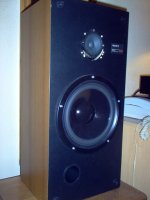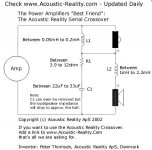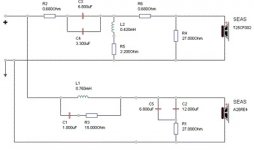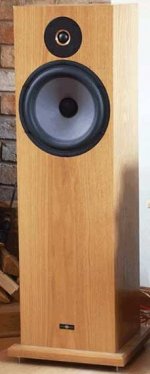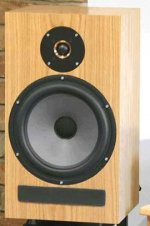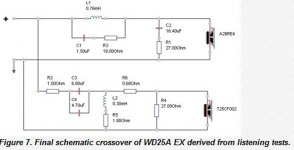Absolutely! Tweeter and woofer😉
Cheep but good sounding. Don't know how they (WLM) can charge the obscene amounts for them!
If you have a high perceived value product, you price to value, not to cost to make. That's how money is made.
Last edited:
The WLM La Scala got me interested in cone tweeters and lively 8" bass. 🙂
6moons audio reviews: WLM La Scala
Clearly those cheapie drive units are doing something right to compete at the high end. I've built many variations on the theme: LR4, BW3, LR2 with varying crossover points, and whilst some are better than others, they never fail but to impress me with their lovely musical quality. 😎
Very enjoyable photo set by Hannes Frick of WLM here:
https://www.flickr.com/photos/hannes_frick/sets/72157623773218942/
I was wrong in thinking it was the 8 ohm W200S that WLM use. The 4 ohm version actually plays more nicely on a series crossover in Boxsim. It is my conceit that I have actually improved the simple WLM crossover in my test rig. But I'm not telling, beyond it being 5 element. After all, WLM staff have children to feed, and no-one can fault their construction standards or commitment to musicality. 😀
An externally hosted image should be here but it was not working when we last tested it.
6moons audio reviews: WLM La Scala
Clearly those cheapie drive units are doing something right to compete at the high end. I've built many variations on the theme: LR4, BW3, LR2 with varying crossover points, and whilst some are better than others, they never fail but to impress me with their lovely musical quality. 😎
Very enjoyable photo set by Hannes Frick of WLM here:
https://www.flickr.com/photos/hannes_frick/sets/72157623773218942/
I was wrong in thinking it was the 8 ohm W200S that WLM use. The 4 ohm version actually plays more nicely on a series crossover in Boxsim. It is my conceit that I have actually improved the simple WLM crossover in my test rig. But I'm not telling, beyond it being 5 element. After all, WLM staff have children to feed, and no-one can fault their construction standards or commitment to musicality. 😀
Attachments
I took another look at my attempt and it appears I must have made some error inputting the data and/or I've completely misunderstood what I'm doing with Boxsim!A couple of months back I had a go at Boxsim, using the Seas A26RE4 and T35 data sheet curves and parameters. I designed a large sealed box with AR series style crossover and the results looked OK. Saying that I've no practical experience designing speakers and it was the first time I tried Boxsim! I could try emailing the files if they're any use to anyone.
I took another look at my attempt and it appears I must have made some error inputting the data and/or I've completely misunderstood what I'm doing with Boxsim!
Importing data is hard in Boxsim, but I think you might well succeed with a series filter with these drive units!
SEAS A26 Kit
We had a guy unhappy with his similarly simple Epos M12i speakers a while back. Which used unfiltered bass. He wasn't interested in this idea and dumped them. Silly boy, IMO.
It's better to use a second order tweeter though, IMO. Which means adding a capacitor in series with the tweeter.
Attachments
Has anybody succeeded in building something like this? Do you think this would be too difficult for a first DIY speaker project? I wouldn't expect it to be as good or pretty as a Devore, but I think it would be a fun project
So the calculated volume for the O/93 is about 64 liters and the Vas of the Seas A26RE4 is 169 liters. Assuming that the A26RE4 is similarly spec'd to the driver used on the O/93, could someone please explain to this speaker design noob how one arrives at a cabinet volume of 64 liters?
Ideal is different from what a company believes that a customer will tolerate in the living room.
And I'm not completely sold that it is the a26 exactly..........
And I'm not completely sold that it is the a26 exactly..........
DeVore Fidelity has made a smart decision to build a ported
cabinet. One can easily stuff the ports gradually to meet one's
own taste. Interesting how most of the manufacturers display
unrealistic sensitivity figures.
cabinet. One can easily stuff the ports gradually to meet one's
own taste. Interesting how most of the manufacturers display
unrealistic sensitivity figures.
Thanks for the responses so far. I guess what I am really asking, as a total noob on speaker cabinet design, is what would be the design considerations that would lead one to this cabinet volume/dimensions assuming one was using the Seas A26RE4, as opposed to something larger like the O/96 (77 liters) or smaller like the Audio Note AN-E (54 liters)? If someone experienced could walk through the hypothetical, it would be greatly appreciated!
Member
Joined 2009
Paid Member
The woofer of the Orangutans is definitely not the Seas A26RE4 since there's a phase plug instead of a dust cap. I assume it's a variant with a stronger magnet which results in higher sensitivity and lower volume requirement due to the lower Qts.
Last edited:
The woofer of the Orangutans is definitely not the Seas A26RE4 since there's a phase plug instead of a dust cap. I assume it's a variant with a stronger magnet which results in higher sensitivity and lower volume requirement due to the lower Qts.
Agreed, but the Orangutan woofer is likely only incrementally different from the A26RE; not fundamentally different. My bet would be that at least early prototypes of the Orangutans used the A26RE. So I am assuming that the design considerations for whatever is used in the Orangutans is essentially the same for the A26RE.
This is a very interesting Orangutan clone IMO:
Designing Loudspeakers - WD25T EX - The next step
H1411-08 A26RE4
E0011-06 T25CF002
A fine article by Peter Comeau. He does something I like myself, and taken a free-running sort of smooth bass and given it just a LITTLE response shaping and 2kHz crossover.
The bass filter doesn't do an awful lot, but always sounds better than nothing at all IMO. It's quite an expensive SEAS Millenium tweeter, but I think you could use a DeVore Morel waveguide type too. The Monacor DT 300 with waveguide is more affordable. Not rocket-science, for sure. I'd take that on.
Designing Loudspeakers - WD25T EX - The next step
H1411-08 A26RE4
E0011-06 T25CF002
A fine article by Peter Comeau. He does something I like myself, and taken a free-running sort of smooth bass and given it just a LITTLE response shaping and 2kHz crossover.
The bass filter doesn't do an awful lot, but always sounds better than nothing at all IMO. It's quite an expensive SEAS Millenium tweeter, but I think you could use a DeVore Morel waveguide type too. The Monacor DT 300 with waveguide is more affordable. Not rocket-science, for sure. I'd take that on.
Attachments
I guess what I am really asking, as a total noob on speaker cabinet design, is what would be the design considerations that would lead one to this cabinet volume/dimensions
That's always a trade-off between cabinet size, frequency response, transient response and excursion limit. 64 liters is rather small for the A26. Unless a very low tuning frequency is chosen a peak at 60 Hz will show up in the frequency response.
Ideal 4th order ported wants 6ft3 but gives an f3=fs=25hz.
My 15's would like 8ft3 each for an f3 ported of 30hz, but they have more cone and more xmax.
For my music and higher volumes, I couldn't run it as a 2-way, the bass would distort the midrange unless I ran it crossed at 120hz from a receiver. If I did that, I wouldn't need to build a box that big to go that low.
But a sealed .707 maybe 3ft3 with 50hz f3, that can work.
Since last time I chimed in, I found out that the cat378 has ferrofluid which can rob detail compared to my jbl compression driver.
I'm still impressed with that 10".
My 15's would like 8ft3 each for an f3 ported of 30hz, but they have more cone and more xmax.
For my music and higher volumes, I couldn't run it as a 2-way, the bass would distort the midrange unless I ran it crossed at 120hz from a receiver. If I did that, I wouldn't need to build a box that big to go that low.
But a sealed .707 maybe 3ft3 with 50hz f3, that can work.
Since last time I chimed in, I found out that the cat378 has ferrofluid which can rob detail compared to my jbl compression driver.
I'm still impressed with that 10".
Yup. Half the 169L Vas for Closed box Qtc 0.707 I reckon. Qts 0.39. So 85L or 3 cu. feet. The above Tower WD25T EX is closed box from the impedance curve.
H1411-08 A26RE4
Here's the smaller WD25A EX, which looks like 45L with a damped aperiodic vent.
Designing Loudspeakers - WD25A The Final Crossover
Can't see the crossover is significantly different from the bigger stablemate. 🙂
H1411-08 A26RE4
Here's the smaller WD25A EX, which looks like 45L with a damped aperiodic vent.
Designing Loudspeakers - WD25A The Final Crossover
Can't see the crossover is significantly different from the bigger stablemate. 🙂
Attachments
Not to detract too much from the Devore's but I always thought they were based on the Snell's which I thought were picked up by AudioNote, such as this one:
Quite fun to listen to and work well in corners. A solid B speaker.
An externally hosted image should be here but it was not working when we last tested it.
Quite fun to listen to and work well in corners. A solid B speaker.
Yup.
I still like the a26 kit.
Just have to slide the tweeter back for time alignment.
And use 3ft3 box (sealed) with felt inside.
I still like the a26 kit.
Just have to slide the tweeter back for time alignment.
And use 3ft3 box (sealed) with felt inside.
Just keep in mind that the performance of these kits is in large part due to the very large front baffle though. If you try to make a very narrow front baffle, or put the tweeter into a small, recessed housing it won't be the same.
If you want the original sound + time alignment, DSP may be in your future. 🙂
Best,
Erik
If you want the original sound + time alignment, DSP may be in your future. 🙂
Best,
Erik
- Home
- Loudspeakers
- Multi-Way
- Devore Orangutan Clone?
